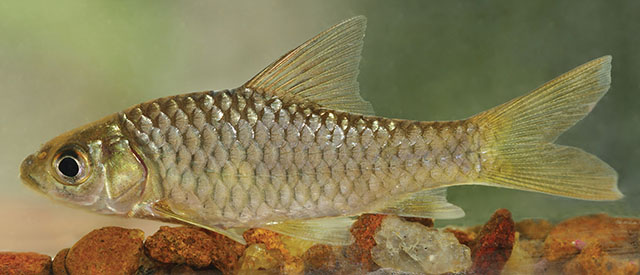| Cyprinidae (Minnows or carps), subfamily: Smiliogastrinae |
| 7.27 cm SL (male/unsexed) |
|
benthopelagic; freshwater |
| Asia: Sri Lanka: widely distributed in the wet-zone lowlands of Sri Lanka (rainfall >2,500 mm yr-1), where it occurs in streams, rivers and marshes between the Kelani-River basin draining to the island’s west, and the Gin River basin to the south. |
|
Can be distinguished from all Sri Lankan and peninsular-Indian congeners by having ½4/1/2½ scales in transverse line between mid-dorsal scale row and pelvic-fin origin and lacking any prominent markings on fins and body in both living and preserved examples. Additionally, it is distinguished from the Sri Lankan and peninsular Indian species of Puntius that most closely resemble it as follows: from P. amphibius sensu stricto by having the head length 28.8-31.2% (vs. 26.4-28.3%) SL; eye diameter 7.7-10.2% (vs. 6.6-7.3%) SL; maxillary barbel 3.7-5.3% (vs. 3.1%) SL; and 16+14 vertebrae (vs. 17+14); from P. dorsalis by its smaller size (maximum standard length 72 mm, vs. 133 mm); and lacking any prominent markings on fins and body (vs. black blotches on base of dorsal and caudal fins); and from P. mahecola by its smaller maximum size (up to 73 mm SL, vs. 89 mm SL in P. mahecola), and by lacking a black blotch, larger than eye, across about 3½ scales of the caudal peduncle (Ref. 77057). |
|
|
Endangered (EN); Date assessed: 29 July 2019 (B1ab(iii)+2ab(iii)) Ref. (130435)
|
| harmless |
Source and more info: www.fishbase.org. For personal, classroom, and other internal use only. Not for publication.

